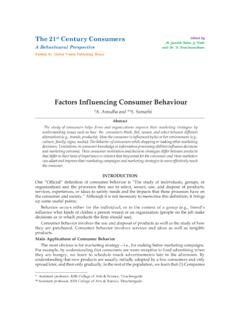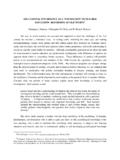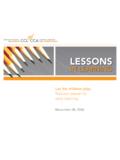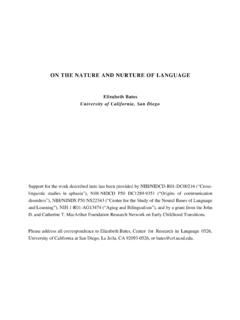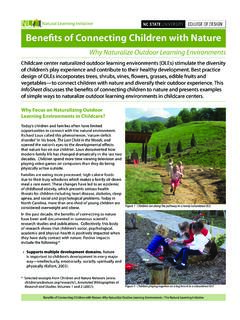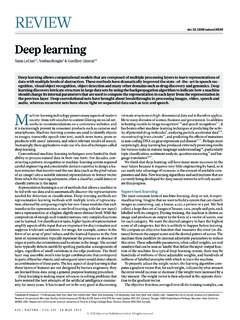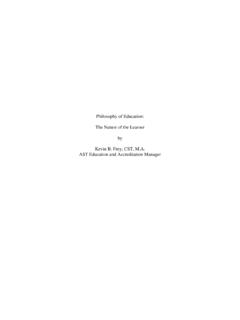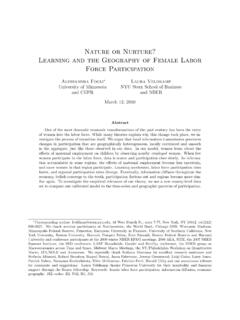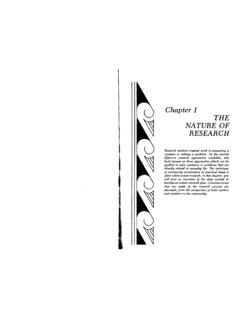Transcription of Learning Disabilities: Nature, Causes and …
1 Learning disabilities : nature , Causesand InterventionsAnuradha Bhandari* and Gitanjali Goyal**A Learning disability, or specific developmental disorder, is a disorderthat inhibits or interferes with the skills of Learning . Learningdisabilities are life disabilities ; they are seen in children as well asadults. The impairment may be so subtle that it may go undetectedthroughout the life. These disabilities create a gap between thetrue potential and day-to-day productivity and performance. Thesame Learning disabilities that interfere with reading, writing andarithmetic interfere with cricket, football, getting dressed, keepingthe room tidy, , with every aspect of an individual does not benefit from a regular educationprogramme and is not socially disadvantaged, intellectually limitedor pedagogically deprived and shows no evidence for hard signneurophysiological dysfunction, that individual is characterized aslearning disabled.
2 The child who has difficulty communicatingeither expressively or receptively and cannot read, write or domathematics within the criterion range as established per schoolnorms is Learning disabilities : nature , Causes and InterventionsCounsellingTheory, Research and PracticePublished by Global Vision Publishing HouseEdited byNov Rattan SharmaAshok K. KaliaAkbar Husain*Professor, Department of Psychology, Panjab University Chandigarh.**Clinical Psychologist, Department of Psychiatry, Govt. Medical Collegeand Hospital Sector-32, : Theory, Research and PracticeLearning disabilities refers to a disorder that interferes withone s ability to store, process or produce information. Suchdisorders may be manifested by specific delays in earlydevelopment and/or difficulties in any of the following areas:attention, memory, reasoning, coordination, communication, reading,writing, spelling, calculation, social competence and emotionalmaturation.
3 Learning disabilities are intrinsic to the individual andmay affect Learning and behaviour in any individual, includingthose with potentially average, average, or above averageintelligence. Learning disabilities may arise from genetic variation,bio-chemical factors, events in the pre- to post-natal period, orany other subsequent events resulting in neurological Fourth Edition Text Revision of the Diagnostic andStatistical Manual of Mental Disorders (DSM-IV-TR, a handbookthat mental health professionals use to diagnose mental disorders)uses the term Learning disorders, formerly called academic skillsdisorders and defines this as cognitive difficulties arising frombrain dysfunction. The use of the term Learning disability is muchmore widely recognized than the term Learning disorder, perhapsbecause Learning disability terminology has been used more oftenin clinical, research, educational and political circles than hasDSM terminology.
4 This paper will use Learning disability terminologyand Learning disability research and statements about learningdisabilities may be assumed to apply directly to DSM-IV StudiesThe prevalence of Learning disabilities varies considerablybased on the criteria used, but estimates are in the range of 5-10per cent (Pennington, 1991; United States Department ofEducation, 1995). Estimates by the Department of Educationset Learning disability prevalence at about 5-6 per cent based onlegal definitions. On the basis of a survey conducted in rural165 Perimpilavu, a city in South India, Suresh and Sebastian (2003)concluded that specific Learning disability was observed in at least7-8 per cent of the general population. Kapur (1993), in a studyon urban primary school children from low socio-economic statusfound 17 per cent of them had scholastic backwardness.
5 Rozario(1991), found in a sample of 110, nine-year-old children nearlyone-third to be scholastically backward; a majority of them hadspecific Learning estimated 2-5 per cent, about half of all Learning disabledidentified by schools have reading disabilities (dyslexia), themost common of the Learning disabilities (Kronenberger & Meyer,2001). Prevalence studies find rates ranging between 2 and 8 percent (Sadock & Sadock, 2003). There are three to four males forevery female with reading disabilities (Spafford & Grosser, 1996).About 1 per cent of school age children have mathematicsdisabilities (dyscalculia), which is approximately one of every fivechildren with Learning disabilities . Precise prevalence rates aredifficult to ascertain because studies on children have lumpedseveral disabilities together rather than separating them intoindividual disabilities .
6 Mathematics disabilities may occur withgreater frequency in females (Sadock & Sadock, 2003). About 4per cent of school age children have writing disabilities (dysgraphia),the prevalence of it alone has not been studied. There are threemales for every female with writing disabilities (Sadock & Sadock,2003).Definition of Learning DisabilitiesKirk (1962), defined Learning disability as a retardation,disorder or delayed development in one or more of the processesof speech, language, reading, spelling, writing or arithmetic resultingfrom a possible cerebral dysfunction and/or emotional or behaviouraldisturbance and not from mental retardation, sensory deprivation,or cultural or instructional factors . Learning disabilities : nature , Causes and Interventions166 Counselling: Theory, Research and PracticeThe National Joint Committee on Learning disabilities (NJCLD, 1988) defined Learning disabilities as follows: Learningdisabilities is a general term that refers to a heterogeneous groupof disorders manifested by significant difficulties in the acquisitionand use of listening, speaking, reading, writing, reasoning, ormathematical abilities.
7 These disorders are intrinsic to the individual,presumed to be due to central nervous system dysfunction andmay occur across the life span. Problems in self-regulatorybehaviours, social perception and social interaction may exist withlearning disabilities but do not, by themselves, constitute a learningdisability. Although Learning disabilities may occur concomitantlywith other disabilities ( , sensory impairment, mental retardation,serious emotional disturbance), or with extrinsic influences (suchas cultural differences, insufficient or inappropriate instruction),they are not the result of those conditions or influences (NJCLD,1988).The 1999 Federal Register that contains the regulations foridentifying and defining students with specific Learning disabilitiesunder US legislation outlined criteria that should be considered inidentifying students with this disorder.
8 The disability must resultfrom a deficit in one or more basic Learning behaviours such asmemory, reasoning, organization and perception; must manifestitself in the form of one or more significant Learning difficulties inone or more of seven areas oral expression, listeningcomprehension, written expression, basic reading skills, readingcomprehension, mathematics calculation and mathematicalreasoning-compared with other children of the same age; must beevidenced by a severe discrepancy between intellectual abilityand academic achievement in at least one of these seven areas;and must not be caused by mental retardation, hearing or visionimpairment, motor impairment, emotional and behavioural disorder,or environmental disadvantage ( Department of Education,1999).167 Another method of defining and characterizing learningdisabilities is through the DSM -IV which outlines three majortypes of Learning disorders: reading disorder, mathematics disorderand disorders of written expression, as opposed to offering onegeneral definition.
9 However, the descriptions of these disorders inthe DSM-IV share one important similarity with that found in theFederal Register. Both stipulate that there must be a discrepancybetween achievement in the area in question and federal law, public schools consider a child to belearning disabled if his or her level of academic achievement istwo or more years below the standard for age and IQ to Bender (1995), discrepancy criteria are used toindicate a substantial difference between intelligence, as measuredon standardized IQ assessments and achievement in a number ofacademic subject areas. Several researchers have questioned theoverall validity and usefulness of the ability achievementdiscrepancy concept. On the basis of their research, Stanovichand Siegel (1994), have concluded that if there is a special groupof children with reading disabilities who are behaviourally,cognitively, genetically, or neurologically different, it is becomingincreasingly unlikely that they can be easily identified by using IQdiscrepancy as a proxy for the genetic and neurological disabilities are intrinsic to the individual and thebasis of the disorders is presumed to be due to central nervoussystem dysfunction.
10 For the individual with Learning disabilities ,evidence of central nervous system dysfunction may or may notbe elicited during the course of a medical-neurological critical elements in the diagnosis of Learning disabilities areelicited during psychological, educational and/or languageassessments. The failure to learn or to attain curricularexpectations may occur for diverse reasons. Learning disabilitieshave their basis in inherently altered processes of acquiring andLearning disabilities : nature , Causes and Interventions168 Counselling: Theory, Research and Practiceusing information. It is essential to understand this notion if one isto appreciate the resultant interaction between the learner andthe Learning environments. An understanding of this interactionfacilitates the development of effective service delivery modelsand adaptive curriculum.
